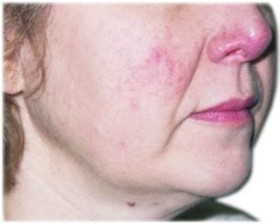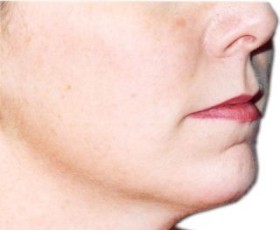These unsightly dilated blood vessels and red blotches on the face affect millions of people, seen almost exclusively in patients with fair skin, and are often associated with chronic sun exposure. Although they are not a medical emergency, many of our patients would like to get rid of these unattractive distractions to their natural beauty.
Fortunately, our state of the art lasers at the Vein & Laser Center enable us to safely, easily and effectively treat these facial broken vessels (called Telangiectasias) with no or minimal down time.
The causes are not known of this condition, but often it is associated with sun exposure, rosacea, overuse of cortisone creams, certain autoimmune diseases such as lupus, oral contraceptive pills, hormone therapy, and occasionally they may be hereditary. In many cases, the exact cause is unknown.
Unlike leg veins, which are induced and aggravated by gravity, facial telangiectasia are usually capillaries or small arteries (arterioles) in the papillary dermis, with weakened elastic fibers in their walls which allow them to dilate and become visible. They can be classified according to their appearance as linear, arborizing (branching), spider, or punctate telangiectasia. The linear and arborizing type occur most commonly around the nose, and the spider type are most common on the cheeks.
 |
|
Before |
After Two Treatments |
Treatment:
New laser technology makes use of the principle of Selective Photothermolysis which allow us to deliver the precise dosage of energy to destroy abnormal blood vessels while sparing the surrounding tissue. The Pulse Dye Laser (PDL) laser emits a brilliant yellow light at 585 - 595nm, close to a major absorption peak of hemoglobin in blood. The blood in the targeted vessel selectively absorbs the laser energy more than the surrounding tissues. The absorbed light is converted into thermal energy, heat, and selectively damages the targeted lesion without causing purpura or damaging the skin. The clogged damaged vessels are slowly absorbed by the body. Larger bluish vessels will be treated with a variable long pulse Nd-Yag laser. Prior to your treatment, will review your medical history, determine your skin type and vessels size.
Typically, multiple treatments are needed to achieve optimal results although most of our patients are very satisfied after only one treatment. Using PDL laser for the tiny red vessels and the Nd-Yag laser for larger bluish ones, enabled us at the Vein & Laser Center to achieve acceptable results with one to three treatments. Treatments are spaced at four to six weeks intervals.
No anesthesia is needed for treatment of facial telangiectasia. The laser pulses feel like little "snaps", and can be easily tolerated by most patients. Our Lasers are equipped with patented Dynamic Cooling Devices that spray the skin with cooling cryogen before and / or after the laser pulse hits the skin. It provides protection to the skin and reduces pain.
Temporary redness, bruising, and swelling may occur after the treatment but usually subside within few hours to few days. This can be covered with make up if desired. Skin lightening (Hypopigmentation) and skin darkening (Hyperpigmentation) is more common with darker or tanned skin. If this occurs, usually it resolves spontaneously within 2-6 months. Scarring is extremely rare.
Results can be maintained only if you use sun protection (sun screen SPF 25 or higher) and avoid sun exposure. Over time, new vessels may grow, but these can be treated again. Treatments usually take several minutes.
|
|
Before Laser |
After ONE Laser (PDL) Treatment |
|



